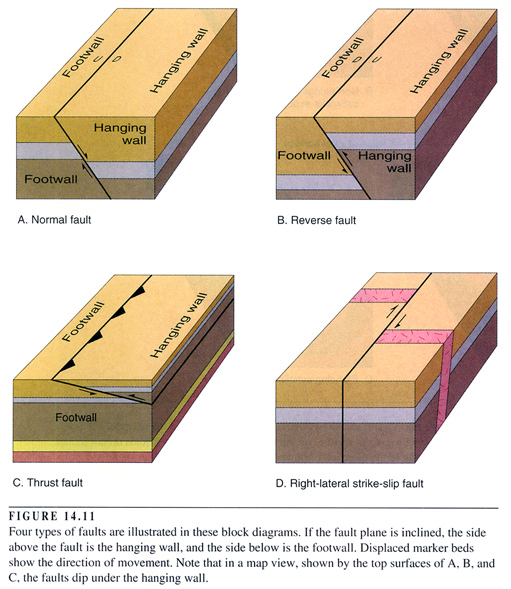In a normal fault the hanging wall moves downwards relative to the foot wall.
Normal fault hanging wall movement.
This is literally the reverse of a normal fault.
We distinguish between dip slip and strike slip hanging wall movements.
Normal faults and reverse faults are dip slip faults they experience vertical movement in line with the dip of the fault.
An upthrown block between two normal faults dipping away from each other is a horst.
Hanging wall movement determines the geometric classification of faulting.
The forces creating reverse faults are compressional pushing the sides together.
The hanging wall moves up and over the footwall.
Thrust faults with a very low angle of dip and a very large total displacement are called overthrusts or detachments.
A fault trace is also the line commonly plotted on geologic maps to represent a fault.
There are three or four primary fault types.
Reverse dip slip faults result from horizontal compressional forces caused by a shortening or contraction of earth s crust.
Reverse faults form when the hanging wall moves up.
The terms hanging wall and foot wall refer to the relative position of the plates after movement.
In this type of fault the hanging wall and footwall are pushed together and the hanging wall moves upward along the fault relative to the footwall.
They are caused by extensional tectonics.
They bound many of the mountain ranges of the world and many of the rift valleys found along spreading margins.
Faults showing vertical movement include tensional normal and compressional reverse faults.
If the motion was down the fault is called a normal fault if the movement was up the.
Thrust faults are reverse faults that dip less than 45.
Normal dip slip faults are produced by vertical compression as earth s crust lengthens.
In a normal fault the hanging wall moves downward relative to the footwall.
They are identified by the relative movement of the hanging wall and foot wall.
Faults are classified according to the direction of relative movement along the fault.
A downthrown block between two normal faults dipping towards each other is a graben.
Together normal and reverse faults are called dip slip faults because the movement on them occurs along the dip direction either down or up respectively.
Dip slip movement occurs when the hanging wall moved predominantly up or down relative to the footwall.
These are often found in intensely deformed.
Economic minerals often grow along faults and these terms come from where a miner would stand and where they would hang their lantern.
Tensional faults are produced through tension extension or pulling apart of the crust causing the hanging wall to move down relative to the footwall.
Low angle normal faults with regional tectonic significance may be designated detachment faults.
They are common at convergent boundaries.
Faults are subdivided according to the movement of the two blocks.
Other articles where normal fault is discussed.
Fault types three main types of faults.

